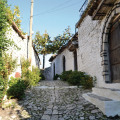CITADEL OF BERAT
Superb. Home to numerous churches, the country's oldest mosque (in ruins) and the prestigious Onufri Icon Museum.
Situated on the hill of Mangalem, 187 m above sea level, this citadel (Kalaja e Beratit) is one of Albania's tourist gems. Its half-destroyed walls and 24 decapitated towers give it a menacing appearance. Once through the large arched gate at the northern entrance, you discover a much less hostile world: a small, peaceful and romantic village of 10 hectares. A tangle of narrow streets with slippery cobblestones, churches (mostly closed) adorned with frescoes painted by the great Onufri and his followers in the 16th and 17th centuries, beautiful views over the Osum valley, a minaret, grandmothers selling knitwear and lace, the fine hotel-restaurant Klea and the precious Onufri Museum. The site was fortified by the Illyrians at the end of the5th century BC. The fortress was destroyed by the Romans in 200 B.C., but then constantly reinforced by the Byzantines, as it was used to control passage along the Via Egnatia. In 1280-1281, the citadel was besieged by the last son of King Louis VIII of France, Charles I of Anjou, King of Sicily. But it remained under the control of the Byzantine prince of Epirus Michel II Comnène, whose initials (MK) can be seen on the main gate. After the Byzantines withdrew, the citadel passed from hand to hand before being occupied from 1417 by the Ottomans, who repulsed Skanderbeg's troops in extremis in 1445. Only the bloodthirsty Ali Pacha de Tepelena managed to seize it by deception in 1808.
Albania's oldest mosque. Built on a triangular plan following the relief, the citadel is surrounded by fortifications measuring approximately 620 m north-south and 410 m east-west. It was within these walls that most of Berat's population was concentrated until the 19th century. A few dozen inhabitants still live here, in stone houses dating from the 18th and 19th centuries. On a north-south axis, rue Mbrica leads to a network of narrow streets where the main sights are well signposted. Of the forty churches in the citadel, half of which date from the Byzantine period, only ten have survived the upheavals of history. There are also two ruined mosques. To the south-west of the ramparts, in the "Citadel" bastion between the Church of the Holy Trinity and the Red Mosque, the White Mosque (Xhamia e Bardhë) is the oldest mosque in Albania. It was built shortly after the capture of Berat by the Ottomans in 1417 to serve the needs of the garrison and merchant caravans.
Did you know? This review was written by our professional authors.
Members' reviews on CITADEL OF BERAT
The ratings and reviews below reflect the subjective opinions of members and not the opinion of The Little Witty.













Les murailles sont en bon état et on y a une belle vue sur la vieille ville et alentour. Ne pas manquer de voir sur un de ses flancs la ravissante église byzantine très photogénique.